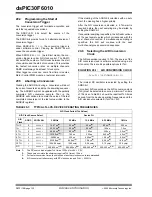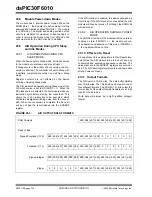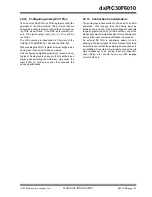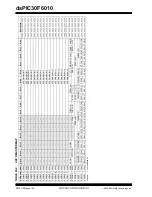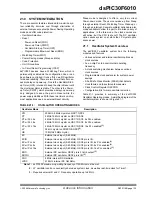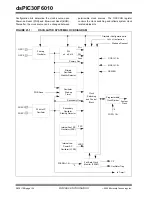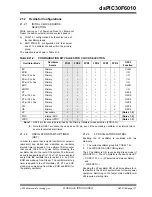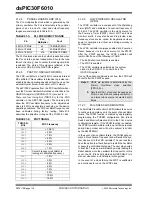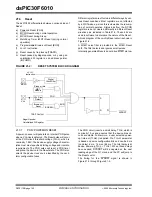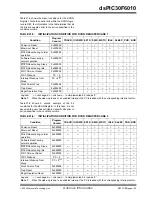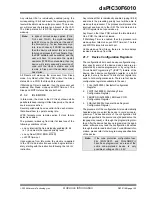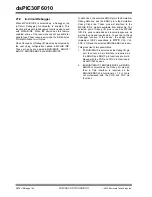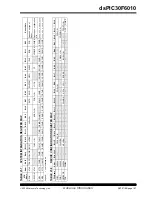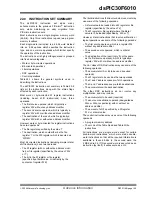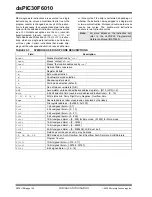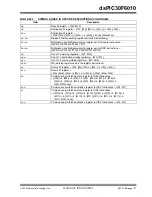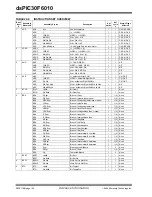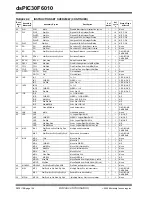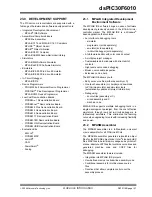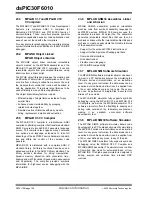
dsPIC30F6010
DS70119B-page 144
Advance Information
2004 Microchip Technology Inc.
21.4
Watchdog Timer (WDT)
21.4.1
WATCHDOG TIMER OPERATION
The primary function of the Watchdog Timer (WDT) is
to reset the processor in the event of a software mal-
function. The WDT is a free running timer, which runs
off an on-chip RC oscillator, requiring no external com-
ponent. Therefore, the WDT timer will continue to oper-
ate even if the main processor clock (e.g., the crystal
oscillator) fails.
21.4.2
ENABLING AND DISABLING THE
WDT
The Watchdog Timer can be “Enabled” or “Disabled”
only through a configuration bit (FWDTEN) in the
configuration register FWDT.
Setting FWDTEN =
1
enables the Watchdog Timer.
The enabling is done when programming the device.
By default, after chip-erase, FWDTEN bit =
1
. Any
device programmer capable of programming
dsPIC30F devices allows programming of this and
other configuration bits.
If enabled, the WDT will increment until it overflows or
“times out”. A WDT time-out will force a device Reset
(except during Sleep). To prevent a WDT time-out, the
user must clear the Watchdog Timer using a
CLRWDT
instruction.
If a WDT times out during Sleep, the device will wake-
up. The WDTO bit in the RCON register will be cleared
to indicate a wake-up resulting from a WDT time-out.
Setting FWDTEN =
0
allows user software to enable/
disable the Watchdog Timer via the SWDTEN
(RCON<5>) control bit.
21.5
Low Voltage Detect
The Low Voltage Detect (LVD) module is used to detect
when the V
DD
of the device drops below a threshold
value V
LVD
, which is determined by the LVDL<3:0> bits
(RCON<11:8>) and is thus user-programmable. The
internal voltage reference circuitry requires a nominal
amount of time to stabilize, and the BGST bit
(RCON<13>) indicates when the voltage reference has
stabilized.
In some devices, the LVD threshold voltage may be
applied externally on the LVDIN pin.
The LVD module is enabled by setting the LVDEN bit
(RCON<12>).
21.6
Power Saving Modes
There are two power saving states that can be entered
through the execution of a special instruction,
PWRSAV
.
These are: Sleep and Idle.
The format of the
PWRSAV
instruction is as follows:
PWRSAV <parameter>
, where ‘
parameter
’ defines
Idle or Sleep mode.
21.6.1
SLEEP MODE
In Sleep mode, the clock to the CPU and peripherals is
shutdown. If an on-chip oscillator is being used, it is
shutdown.
The fail-safe clock monitor is not functional during
Sleep, since there is no clock to monitor. However,
LPRC clock remains active if WDT is operational during
Sleep.
The Brown-out protection circuit and the Low Voltage
Detect circuit, if enabled, will remain functional during
Sleep.
The processor wakes up from Sleep if at least one of
the following conditions has occurred:
• any interrupt that is individually enabled and
meets the required priority level
• any Reset (POR, BOR and MCLR)
• WDT time-out
On waking up from Sleep mode, the processor will
restart the same clock that was active prior to entry
into Sleep mode. When clock switching is enabled,
bits COSC<1:0> will determine the oscillator source
that will be used on wake-up. If clock switch is
disabled, then there is only one system clock.
If the clock source is an oscillator, the clock to the
device will be held off until OST times out (indicating a
stable oscillator). If PLL is used, the system clock is
held off until LOCK =
1
(indicating that the PLL is sta-
ble). In either case, T
POR
, T
LOCK
and T
PWRT
delays are
applied.
If EC, FRC, LPRC or EXTRC oscillators are used, then
a delay of T
POR
(~ 10
µ
s) is applied. This is the smallest
delay possible on wake-up from Sleep.
Moreover, if LP oscillator was active during Sleep, and
LP is the oscillator used on wake-up, then the start-up
delay will be equal to T
POR
.
PWRT delay and OST
timer delay are not applied. In order to have the small-
est possible start-up delay when waking up from Sleep,
one of these faster wake-up options should be selected
before entering Sleep.
Note:
If a POR or BOR occurred, the selection of
the oscillator is based on the FOS<1:0>
and FPR<3:0> configuration bits.
Summary of Contents for dsPIC30F6010
Page 12: ...dsPIC30F6010 DS70119B page 10 Advance Information 2004 Microchip Technology Inc NOTES...
Page 32: ...dsPIC30F6010 DS70119B page 30 Advance Information 2004 Microchip Technology Inc NOTES...
Page 38: ...dsPIC30F6010 DS70119B page 36 Advance Information 2004 Microchip Technology Inc NOTES...
Page 50: ...dsPIC30F6010 DS70119B page 48 Advance Information 2004 Microchip Technology Inc NOTES...
Page 68: ...dsPIC30F6010 DS70119B page 66 Advance Information 2004 Microchip Technology Inc NOTES...
Page 72: ...dsPIC30F6010 DS70119B page 70 Advance Information 2004 Microchip Technology Inc NOTES...
Page 76: ...dsPIC30F6010 DS70119B page 74 Advance Information 2004 Microchip Technology Inc NOTES...
Page 86: ...dsPIC30F6010 DS70119B page 84 Advance Information 2004 Microchip Technology Inc NOTES...
Page 108: ...dsPIC30F6010 DS70119B page 106 Advance Information 2004 Microchip Technology Inc NOTES...
Page 116: ...dsPIC30F6010 DS70119B page 114 Advance Information 2004 Microchip Technology Inc NOTES...
Page 128: ...dsPIC30F6010 DS70119B page 126 Advance Information 2004 Microchip Technology Inc NOTES...
Page 150: ...dsPIC30F6010 DS70119B page 148 Advance Information 2004 Microchip Technology Inc NOTES...
Page 164: ...dsPIC30F6010 DS70119B page 162 Advance Information 2004 Microchip Technology Inc NOTES...
Page 208: ...dsPIC30F6010 DS70119B page 206 Advance Information 2004 Microchip Technology Inc NOTES...
Page 220: ...dsPIC30F6010 DS70119B page 220 Advance Information 2004 Microchip Technology Inc NOTES...
Page 221: ...2004 Microchip Technology Inc Advance Information DS70119B page 221 dsPIC30F6010 NOTES...

